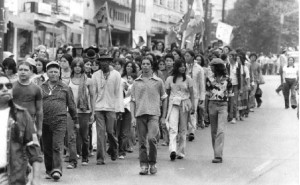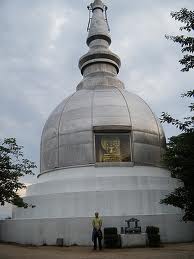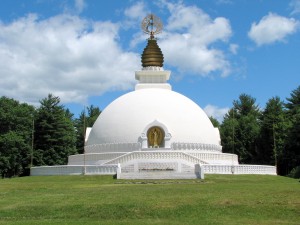About
In 1978, Native Americans organized “The Longest Walk”, wherein participants walked cross-country from San Francisco, California to Washington, DC.
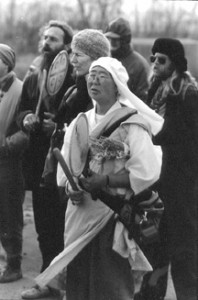 Accompanying them on their walk, was a Japanese Buddhist Nun from the Nipponzan Myohoji order. Since then, Jun Yasuda has crossed the country four more times on foot and logged in several thousand additional miles for the cause of peace. She walks beating her drum while chanting a prayer for peace Na-Mu-Myo-Ho-Ren-Ge-Kyo.
Accompanying them on their walk, was a Japanese Buddhist Nun from the Nipponzan Myohoji order. Since then, Jun Yasuda has crossed the country four more times on foot and logged in several thousand additional miles for the cause of peace. She walks beating her drum while chanting a prayer for peace Na-Mu-Myo-Ho-Ren-Ge-Kyo.
Many times, she has spent days fasting on the steps of the NY State Capitol in Albany for support of freedom for a Native American activist Dennis Banks. In 1983, during one of her fasts, she was approached by Hank Hazelton, a long time activist for Native Americans. Hank had heard of her work and offered her a parcel of land in Grafton, New York, for the purpose of building a “Monument for Peace”.
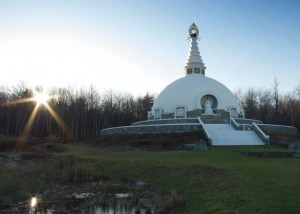 In October 1985, work began on the structure soon to be called the Grafton Peace Pagoda. After 8 years of toil and struggle, the Pagoda was completed and dedicated in the fall of 1993.
In October 1985, work began on the structure soon to be called the Grafton Peace Pagoda. After 8 years of toil and struggle, the Pagoda was completed and dedicated in the fall of 1993.
Since the Japanese Nipponzan Myohoji order is not permitted to solicit money for any reason, the Pagoda was built entirely with donated labor, funds and materials. Many volunteers contributed tens of thousands of hours of labor to complete the Pagoda. Recycled materials and tools also found new life during construction of the project.
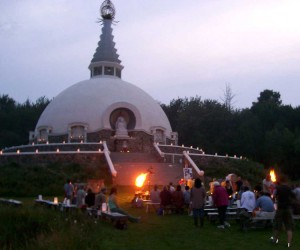 Over the course of time, visitors from many nations and all walks of life began to arrive at the site. Representatives of many faiths; Christians, Jews, Muslims, Hindus, Native Americans, Bahai’s, Sufis, Buddhists, Spiritualists and Agnostics have all been drawn to this special place.
Over the course of time, visitors from many nations and all walks of life began to arrive at the site. Representatives of many faiths; Christians, Jews, Muslims, Hindus, Native Americans, Bahai’s, Sufis, Buddhists, Spiritualists and Agnostics have all been drawn to this special place.
Peace Pagodas are a symbol of non-violence dating as far back as 2000 years ago. During that time, the Emperor Ashoka of India, a notoriously bloody warlord, was approaching after a particularly wretched battle by a Buddhist Monk who admonished him for his wrong doings. From that time on, Ashoka became a became a fervent believer in Buddhism. After his conversion, he gave up his warlike ways and began erecting Peace Pagodas.
In 1931, Nichidatsu Fujii, teacher of the Nipponzan Myohoji order, met Mahatma Gandhi in India. They became friends, and together joined in sending out prayers for peace and non-violence throughout the world even as the clouds of World War II began to grow on the horizon.
“Civiliza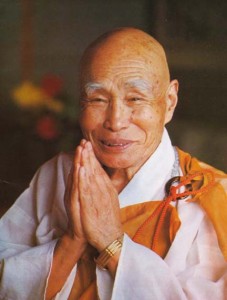 tion is not to kill human beings,
tion is not to kill human beings,
Not to destroy things, not to make war;
Civilization is to hold mutual affection
And to respect one another.”
–Most Venerable Nichidatsu Fujii
Many people ask the question, “what is inside the Peace Pagoda?” The answer is, “nothing but empty space.” Since the first Pagodas were built by the piling of stones on mud, their interiors were solid with no space inside. Although the modern construction techniques used to build the Grafton Peace Pagoda have created an interior space, this area is purposely left unused. All activities take place outside the Pagoda, which is also known as a Stupa.
As of 2000, eighty Peace Pagodas had been built around the world in Europe, Asia, and the United States. There is only one other Peace Pagoda in operation in the USA, located in Leverett, MA (just north of Amherst). A third US Peace Pagoda is now under construction in the Great Smoky Mountains of Eastern Tennessee.
